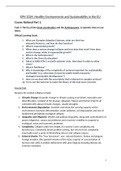Samenvatting
Summary Tutorial Literature/References Notes - Healthy Environments and Sustainability in the EU (EPH1024)
- Instelling
- Maastricht University (UM)
Notes from the readings for all 12 tutorial tasks of this *new* course (Feb – Mar 2021) ** Save yourself 100s of hours of reading and taking notes! ** Cleanly organised & easy to follow! ** All official Learning Goals for each Task and notes for each Reference ** Topics included: Sustainability ...
[Meer zien]




